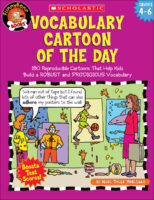Ballew realized that illustrations would help her students with all of their vocabulary words, not just the most confusing ones. Visual cues are important for memorization and learning, and having the students illustrate the words themselves was also a great way to assess their understanding so far.
Ballew wrote each vocabulary word on an index card and took suggestions for how her students might illustrate each one before distributing the cards. Many of the vocabulary words were concrete and fairly easy to illustrate, but the students were also able to depict more abstract words like plentiful and cultivate.
For their next challenge, Ballew’s students illustrated the parts of speech as part of their grammar review lesson. Many students were struggling with the distinction between pronoun and proper noun, as well as adverb versus adjective. But how would they illustrate a word like conjunction?
With fewer words to illustrate, the students worked in teams and once again rose to the challenge of turning abstract vocabulary into concrete illustrations. With these new visual aids, Ballew’s fifth graders were able to revitalize their classroom word wall and find a new way to meaningfully review vocabulary words while boosting comprehension and stickiness.













